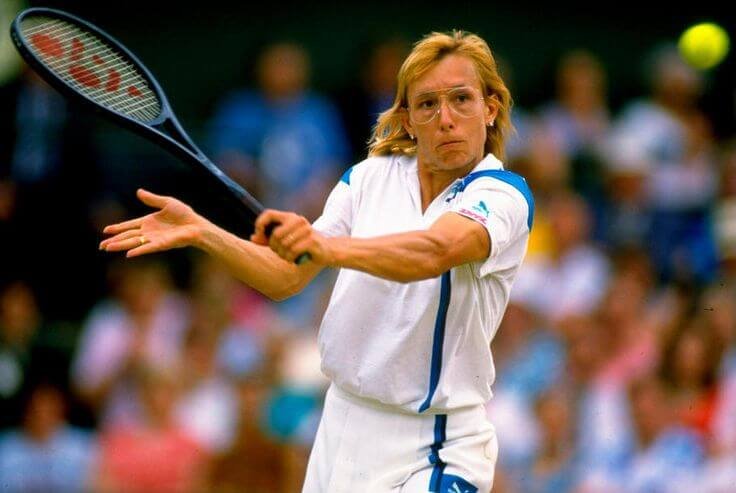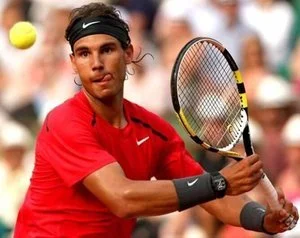The 5 Greatest Left-Handed Tennis Players of All-Time
The Best Left-Handed Tennis Players Ever
Facing a left-hander at the elite level of tennis is a hell of a challenge, ripping up game plans and forcing the receiver to use their potentially weaker backhand.
The southpaw tends to rely on a swinging serve and a bunch of cross-court forehands played with height and topspin.
It can take the opponent out of their comfort zone, plus they get to serve out wide to the righty backhand on 3 out of 4 game points.
Tennis lefty Martina Navratilova
Who better to sum up the difficulties of right-handed players taking on a “lefty” than Roger Federer:
“The way the ball goes out of your strings with different spins, it’s just different, so you have to get used to that quickly. You don’t have much time to waste and you have to be fearless to take on the spinning balls, the sliding balls, the kicking balls.”
Federer will probably know the King of the Lefties quite well…
In this article, find out about the 5 greatest left-handed tennis players of all-time!
5. Jimmy Connors
If winning is the most important aspect of professional sport, then Jimmy Connors is the man you’d choose to deliver.
Boris Becker once downplayed an early exit at Wimbledon in 1987, saying “I lost a tennis match. I didn't lose a war.”
Connors disagreed fervently and proved his point with an incredible comeback against Mikael Pernfors that year in the fourth round, despite a dodgy leg.
Losing two sets to love and 4-1, he roared back to clinch it in the fifth.
Those fist pumps made Jurgen Klopp look like a kitten and propelled Connors to eight majors, including five US Opens.
Jimmy Connors even posted on Twitter: "Happy “Lefty” Day- so many greats from all walks of life— it is a special club- I am proud to be a member !!!".
4. Martina Navratilova
In the 70s and 80s, there was a host of left-handed tennis players gobbling up majors.
This was before racket technology, the rise of the double-handed backhand and more homogenous surfaces could reduce the effect of Navratilova’s dominant serve and volley game, allied to supreme athleticism.
It was a lethal cocktail of invincibility, especially when the southpaw element is taken into consideration.
Chris Evert, who suffered ten defeats in 14 major finals against Navratilova, revealed that people would feel sorry for her: “‘You’re so frail and feminine. We always felt sorry for you.’ It was as if Martina became the bully to some people.”
In some ways, such thoughts had validity.
Between the 1983 Wimbledon match with Andrea Jaeger to the 1984 French Open against Evert, Navratilova won all four single majors in straight sets for an aggregate loss of just 19 games.
3. John McEnroe
Unconventional, uncompromising and with attitude aplenty, John McEnroe’s lefty status seemed to back up everything else about his rogue persona.
The way he caressed the ball through feel rather than force was a thing of thorny beauty- and it is this image that tennis fans can still picture.
Mac’s trademark serve started entirely almost side-on with his head down, but he then became like a twisted coil that triggered everything else about his play.
It was always forward-thinking!
What truly propelled McEnroe was that he used all of his tools to see the game differently.
He even used the old-style Continental grip for his forehand and backhand.
The court was like a giant geometry grid for him where he could find the angles.
On that note, the figures were impressive. He gathered seven Grand Slam singles titles from the late 70s to the early 80s.
2. Rod Laver
Modern spectators only see Rod Laver as the man who approvingly nods from the seats of Melbourne or Wimbledon to appreciate the titans of today.
His televised history is limited, given that he was banned from playing major tournaments when he turned professional in 1962.
His record of winning two calendar Grand Slams in 1962 and 1969 would probably have been doubled had the Australian been able to rejoin the ranks earlier than the Open era in 1968.
Like McEnroe, the Rockhampton Rocket didn’t overpower opponents.
The lithe and diminutive 5’ 8” lefty succeeded through a combination of speed and agility, a ferocious competitive DNA and no real weakness that could be exploited.
Like Nadal, Laver had a beefier left arm than right and said: “I used one of those squeeze things when I was young.”
The International Tennis Hall of Fame site describes it as a “lumberjack’s arm”. He hit thousands and thousands of balls in practice.
The Queenslander was World Number One between 1964-1970, and from 1962-64 he collected 47 championships. Laver won 11 major singles titles and 20 Slams overall.
1. Rafa Nadal
So the story goes that coach Toni “forced” the Spaniard to change to his left hand for tennis. The reality is different.
Uncle Nadal qualified the approach: “I had the impression that he was stronger on his left side than on his right side. So, I figured that he was left-handed; it’s as simple as that.”
Whatever the motivation, it’s worked out pretty well, with a joint slam record of 22 singles titles.
Nadal describes his left arm as beefier- and he calls the tennis court his gym. Opponents were simply exhausted by a long-life battery at the other end.
When 22-year-old Roger Federer played 17-year-Nadal for the very first time, the Swiss commented: “He doesn’t hit the ball flat and hard.
It’s more with a lot of spin, which makes the ball bounce, bounce high, and that’s a struggle I had today. I tried to get out of it, but kind of couldn’t.”
Nadal was a killer in major finals against his old nemesis, especially on his favourite Parisian surface, where he beat Federer three times. Rafa Nadal is without doubt the King of the French Open.
Nadal was a raging bull at his best, even in that magical Australian Open final that he lost to Novak Djokovic.
The one and only Rafa Nadal
The Verdict
Rod Laver has had a court named after him. That’s a legacy. His place in the history books is secure.
However, Rafael Nadal has monstered his way to tennis greatness in so many ways, interrupting the Federer flow and possessing a virtual 50/50 record against the Djoker.
He even came back from the brink at age 35, when he was two sets down to Danill Medvedev in the Australian Open final.
Head to our tennis blog for more!



